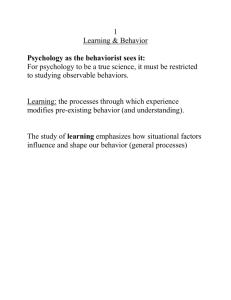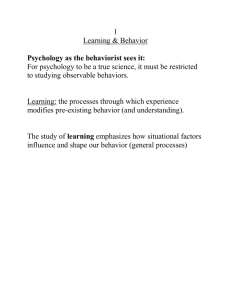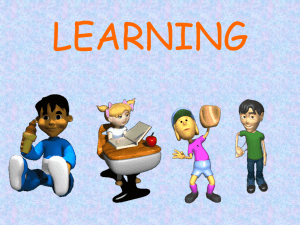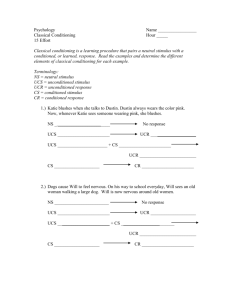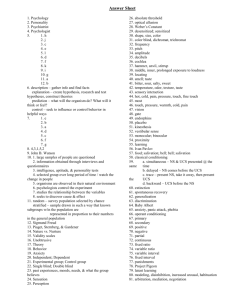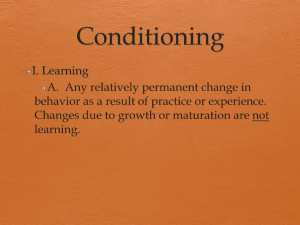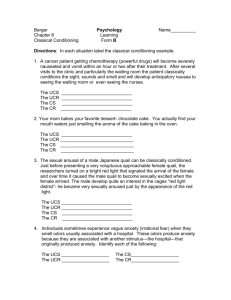Chapter 7.2 Classical Conditioning
advertisement
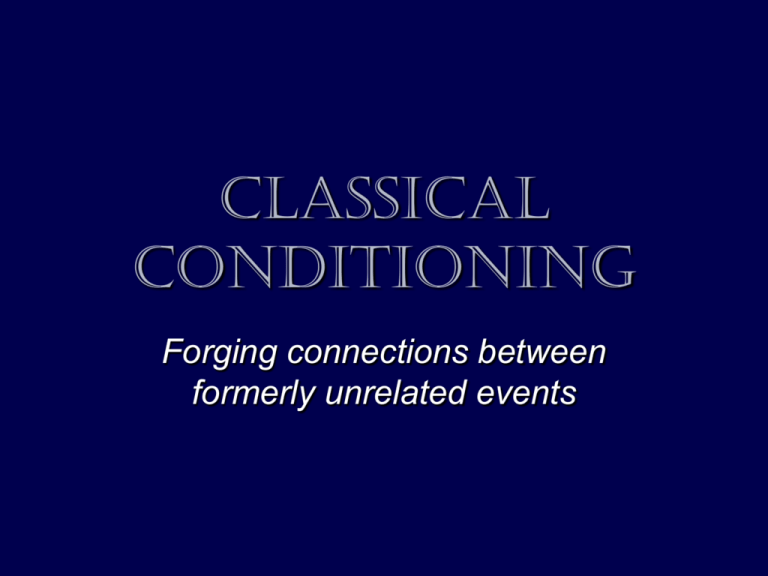
Classical conditioning Forging connections between formerly unrelated events background It all started with Ivan Pavlov and his study of the digestive system Research based on work with animals Wildly successful – 1905 Nobel Prize Studied the automatic connection between food (meat) in the mouth and the flow of digestive juices UCS (meat in mouth) > UCR (saliva) The big idea Start with an unconditioned reflex – an automatic connection between a stimulus and a response (meat>saliva) You can develop new automatic responses by transferring responses from an UCS to an originally neutral stimulus by repetitively pairing them together Let’s say that a different way An air puff in the eye (UCS) will always make us blink (UCR) Flashing a red card won’t But if we repetitively flash the red card, shortly followed by the air puff, eventually, Just flashing the red card will make us blink ! New terms The initially unremarkable red card is a neutral stimulus (NS) The air puff is an UCS The blink after just the puff is a UCR The red card, once it causes a blink all by itself, is a conditioned stimulus (CS) The blink that follows just the red card is a conditioned response (CR) examples That particular corner at you high school The torturer’s black shoes The song from that certain summer that reminds you of ….. Pavlov’s assistants carrying the meat tray The tone before the shock The whistling of a V1 “shrieked” Sexual fetishes definitions Classical conditioning (CC) – process by which an organism learns a new association between two paired stimuli; one of which was initially neutral the other producing an unconditional reflex Unconditioned stimuli (UCS) – an event that constantly and automatically elicits an unconditioned response (UCR) More definitions Unconditioned response (UCR) – an action that an UCS elicits Conditioned response (CR) – action that Conditioned Stimulus elicits; it does not have to be identical to the UCR perspectives CC works across species, from the lowly maggot to the most sophisticated human being In habituation the UCS proved to be meaningless and lost its power over behavior In CC the initially meaningless CS becomes crucial and works a heavy influence on behavior More perspectives CC prepares us for significant events by identifying events that commonly predict them Gives us advance warning of upcoming threats and opportunities The more unfamiliar the CS or the more powerful the UCS the faster the CR takes Other aspects The process that establishes or strengthens a CR is called acquisition A CR can even be a thought Unraveling the connection Extinction – the decrease or extinguishment of the conditioned response In CC, extinction takes place when we repeatedly present the CS without the UCS following it The return of the cs>CR connection Extinction doesn’t erase the CS>CR connection, it inhibits it Spontaneous recovery – the temporary return of the extinguished response after a delay All together now First we build the CS>CR connection through acquisition, Then we unravel it through extinction, If we then stop presenting the CS for a while, once we resume its use, The CR will return, but not for long, unless it is again paired with the UCS Extending the connection The CR can occur even without presentation of the exact CS which formed it, if the new CS is similar enough Stimulus generalization – the extension or broadening of a CR from the original CS to another, similar stimulus The more similar the entire setting is, the more likely the new connection will form Narrowing connections If differing stimuli, although quite similar to the CS, are never, or rarely, followed by the UCS, then the CR will not emerge Stimulus generalization – differing responses to differing stimuli that have been followed by differing events What factor is key to cc? What causes the connection to form? Pavlov thought that the most important element in acquisition was how closely the UCS followed the CS. We call it temporal contiguity or “nearness is good” After all, the longer the break between the CS and the UCS, the weaker the connection. Is it just timing? The concept of blocking. If a CS/CR link has been established, pairing a new CS with the old CS will not work. This is true even if the timing is perfect for the new CS. So, nearness in time is not enough. The power of prediction It’s reliability that counts, the CS’ ability to accurately and consistently predict the UCS. The UCS must be more likely to occur after the CS. The big picture CC involves visceral reactions involving the sympathetic nervous system – you feel it in your gut. It prepares us for important challenges and threats. But it does not tell us what to do. For how we learn voluntary, planned behaviors we turn to operant conditioning.
